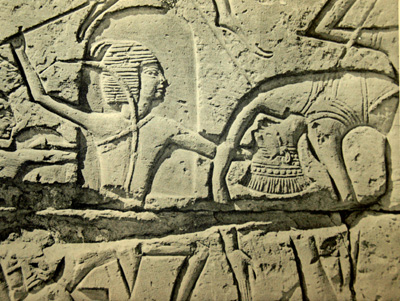The Peleset was one of the Sea Peoples to invade Egypt during the reign of Ramesse III in the fifth and eighth years. They have been identified with the Biblical Philistines ever since the works of Jean-François Champollion in the early 19th century. Like the Sea Peoples in general however, there is no real, firm evidence.
The Peleset (Egyptian Prst/Plst) are almost universally identified with the Philistines of the Bible. The Peleset first appeared in Egyptian texts under Ramesses III. There is no indication as to their origin, although they were 'islanders'. Suggestions have ranged from Crete to Arzawa in Anatolia o Canaan, but there is as yet no clear evidence to resolve the question.
- Cline, Eric, and David O'Connor. "The Mystery of the Sea Peoples." Mysterious Lands. London: UCL, 2003.
One hypothesis for their origins is the similarly elusive Homeric Pelasgian. The Philistines are said to have originated in Caphtor, which in turn has been theorised to be Cyprus or Crete. Incidentally, in Homer's epic Odyssey, the Greek protagonist Odysseus says that:
There is a land called Crete, in the midst of the wine-dark sea, a fair, rich land ... There dwell Achaeans, there great-hearted native Cretans, there Cydonians, and Dorians of waving plumes, and goodly Pelasgians. [19:166].
It has thus been thought that the Pelasgians moved south through Achaean Greece, arriving at Crete and from thence onto Canaan to become the Peleset of Egyptian records. It could also have been that the Pelasgians were refugees from the Mycenaean Collapse, arriving in Egyptian territories as a migratory tribe.
Biblical passages refer to the Philistine's origin as the 'Islands of Caphtor' ... Since many scholars identify Caphtor with Crete, it is widely accepted today that the Peleset were originally Cretan Greeks of the Late Bronze Age. [Philistine pottery finds] are closely related in ware, shape, paint and decorative concepts to examples of the LHIIC period attested in Greece and the Aegean islands.
D’Amato, Raffaele, and Giuseppe Rava. Sea Peoples of the Bronze Age Mediterranean c. 1400 BC–1000 BC. Osprey Publishing, 2015.
But ultimately this is all quite speculative, and there are competing theories that the Peleset originated in Anatolia or Cyprus.





